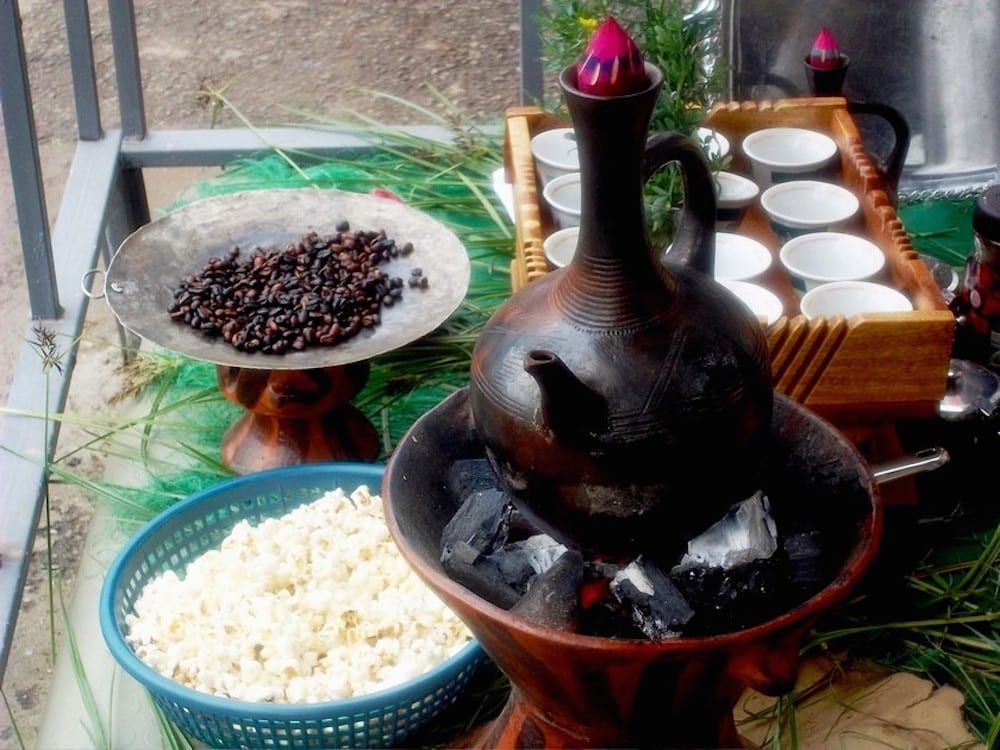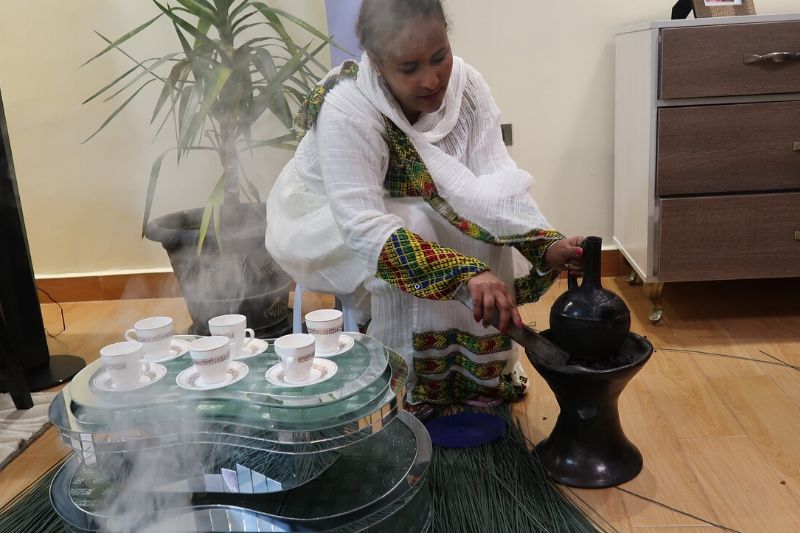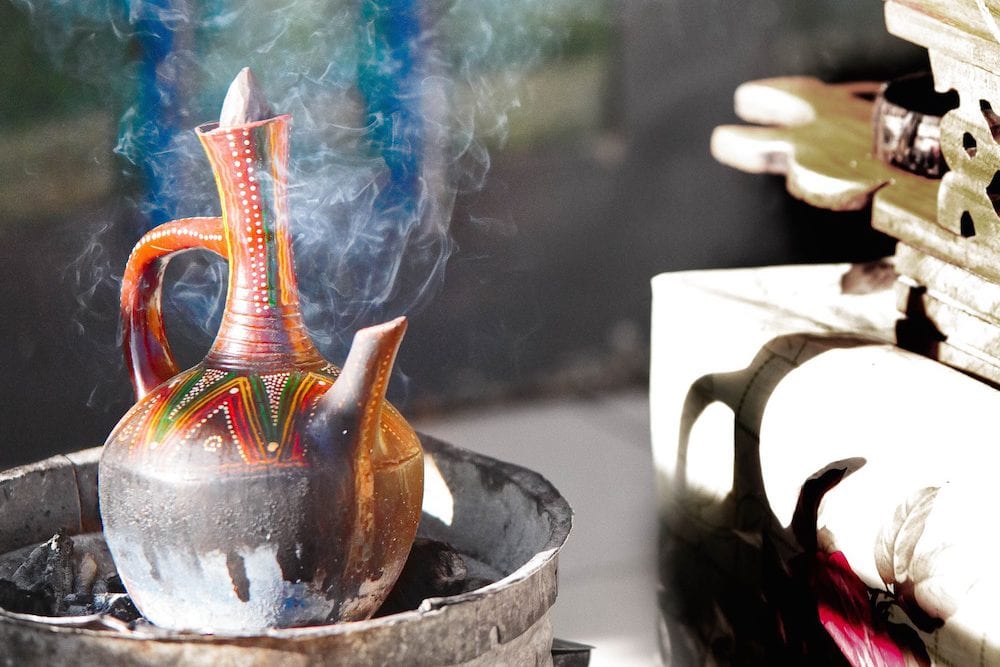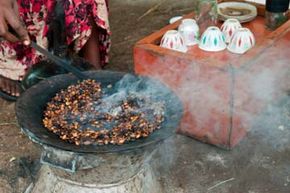ethiopian coffee ceremony name
Friends and neighbours will gather at all hours of the day to share local news and gossip over the steaming hot cups and imbibers will come and go as cups are distributed out by the woman preparing them. The roasted beans are grounded by hand using a bowl and a stick and then transferred to a clay pitcher called jebena.

Buna Time A Crash Course In Ethiopian And Eritrean Coffee Tradition Black Foodie
The traditional coffee ceremony is a central part of Ethiopian life and an important example of Ethiopian.

. Its believed the word coffee derives from Kaffa the name of a place in the South. During the coffee ceremony people. Unlike many other countries coffee has been a tradition to share ideas and feelings.
Ethiopian coffee is amongst the finest in the world with premium washed Arabica beans fetching some of the world markets highest prices. Ethiopian Coffee Ceremony Set and Coffee Making Process. There is a deep meaning in Ethiopian Coffee Ceremony to each of the 3 coffee servings ie.
This account coincides with the commonly held belief that coffee cultivation began in Ethiopia around the ninth century. Traditionally it is women who carry out the coffee ceremony. What is the Ethiopian Coffee Ceremony.
Ethiopian Coffee Ceremony. They are known as the Abol Tona and Baraka. Also the first coffee that comes out is.
The beans are shaken rhythmically in the pan to prevent scorching. Coffee is referred to as Bunna Amharic Buna Oromifa Buna Sidama Buno Gedeo and Bono Kafficho. The Ceremony Process The Ethiopian Coffee Ceremony is one of the most important social customs in Ethiopia.
She gently washed a handful of green coffee beans on a heated long handled round pan. Many believe that the Ethiopian province where the berries first blossomed Kaffa gave its name to coffee. It is thought that the legendary character of Kaldi would have existed around 850 AD.
Its considered the most important social occasion in some. The jebena is an iconic symbol of Ethiopian coffee culture. 1 First round Abole.
You can think of a coffee ceremony as a sort of ritual. At this time most of your senses are being involved in the ceremony. If ordered a waitress will bring a platter of coffee cups a jebena and incense smoldering from a dispenser to your table.
The tradition wants that who leads the ceremony wears an embroidered long white cotton dress. In full view of the guests the ceremony begins. A ceramic hand-made pot called jebana is the coffee brewing apparatus in the Ethiopian Coffee Ceremony.
The pungent smell mingling with the heady scent of incense was filling the room. Traditionally the coffee ceremony in Ethiopia has 3 steps involving 3 cups of coffee. Once ready the coffee is served with popcorn and frankincense melted over the charcoals.
The coffee ceremony is as much about the specific preparation as it is a culture. According to folklore these were the names of the three goats that led to the discovery of coffee more about this later. For example the annual Ethiopian ceremony Coffee Ceremony goes back centuries.
2 Second round Tona 3 Third round Bereka. The Ethiopian coffee beans are carefully moved around so they roast evenly and soon they begin. What is the Ethiopian coffee ceremony.
Every morning the woman in the family roasts fresh coffee in a clay pan possibly with some flavoring. The pitcher is placed on the stone oven to boil the water. Raw url11988coffee url seeds are washed to remove their husks and other debris and then the cleaned seeds are placed in a long-handled pan and held above a small url13280fire url contained in a stone oven.
It is filled with water not surpassing the stout and set on the stove to boil. Once cooled it is poured back in the jebena and the boiling process is done again. Coffee ceremony and community gathering are a crucial part of Ethiopian culture.
The smell snakes around the room making it feel more intimate. Jebena the clay pot used in the coffee ceremony. The story of coffee has its beginnings in Ethiopia the.
The brewing process may be different from any youve seen. It is considered a household staple in Ethiopia and the decorations and designs on it are often used to represent social status. Ethiopian Coffee History.
Ethiopias Unique Coffee CeremonyNo visit to Ethiopia is complete without participating in the elaborate coffee ceremony that is Ethiopias traditional form of hospitality. That starts with the first round of coffee natively named Abol the second one called Tona and the third which is the last is Bereka. It doesnt just go to second but third and they have a name for each round of coffee they drink at just a single gathering.
In some Ethiopian legends the 3 cups of servings of coffee Abol Tona and Baraka refers to the names of the 3 goats that got the first original caffeine buzz thousands of years ago. During the Ethiopian coffee ceremony an integral part of the daily life of most Ethiopians the roasting of the coffee beans or buna is done in a flat iron pan called a baret metad roasting plate which is placed over a small charcoal stove. It is a clay pot with a long neck and narrow spout that is used to brew coffee in the traditional Ethiopian way.
They start by washing the coffee also called Buna in Amharic and then roast the coffee on a flat pan over coal and as the coffee roasts it emits the most enticing smell. The Ethiopian coffee ceremony is usually led by a young woman in front of the guests and everyone is then welcomed forming a circle with a gift such as incense or sugar. However some believe that coffee was cultivated as early as 575 AD.
The coffee is poured from the jebena and cooled. The Ethiopian coffee pot is called a jebena. The traditional Ethiopian coffee is made at a clay pot called jebena heated by coal.
A series of traditional steps taken to make serve and drink coffeeThe Ethiopian Coffee Ceremony is the way it has been done throughout the years in Ethiopia the cradle of the first coffee treesEven though its known as Ethiopian it was also originally practised in other. The coffee will be poured from the jebena for you. Each cup symbolizes a.
It is at the heart of communal life. In Ethiopia coffee is called Bunna pronounced. Each household may participate in coffee ceremony as much as three times a day and offers an opportunity to be hospitable and welcoming to family neighbors and friends.
The coffee beans are finely ground and boiled in.

Look Inside An Ethiopian Coffee Ceremony Demand Africa

Ethiopia Coffee Ceremony Ethiopian Coffee Ceremony Ethiopian Coffee Ethiopian Women

Local Guides Connect Ethiopia Coffee Ceremony Local Guides Connect

When Coffee Becomes The Show Ethiopian Coffee Ethiopian Coffee Ceremony Coffee Roasting

Ethiopian Coffee Ceremony Everything You Need To Know Travel Gluttons

Ethiopian Coffee Ceremony Pichastock

Habesha Inc In Ethiopia Buna Tetu Which Means Drink Coffee Is The Name For The Coffee Ceremony That Can Take Up To Three Hours To Prepare And It Happens Three
How To Perform The Traditional Ethiopian Coffee Ceremony Daily Life Highlights

Tell Us How Do You Drink Your Coffee Name This Campaign Win An Awesome Ethiopian New Year Prize Thro Ethiopian Coffee Ethiopian Coffee Ceremony Coffee Shop

Facts About The Coffee Ceremony In Ethiopia Absolute Ethiopia

Ethiopian Coffee Ceremony As The Top African Producer Of Coffee And Seventh In The World Ethiopia Has A Lo Ethiopian Coffee Ethiopian Coffee Ceremony Coffee

A Look Inside An Ethiopian Coffee Ceremony Afktravel

Ethiopian Coffee Ceremony The Chattery

Traditional Coffee Ceremony Ethiopian Coffee Ceremony Ethiopian Coffee Coffee Tables For Sale
Jebena Brew Guide Ethiopian Coffee Ceremony Prep Eight50 Coffee

Ethiopian Coffee Ceremony Gastro Obscura


